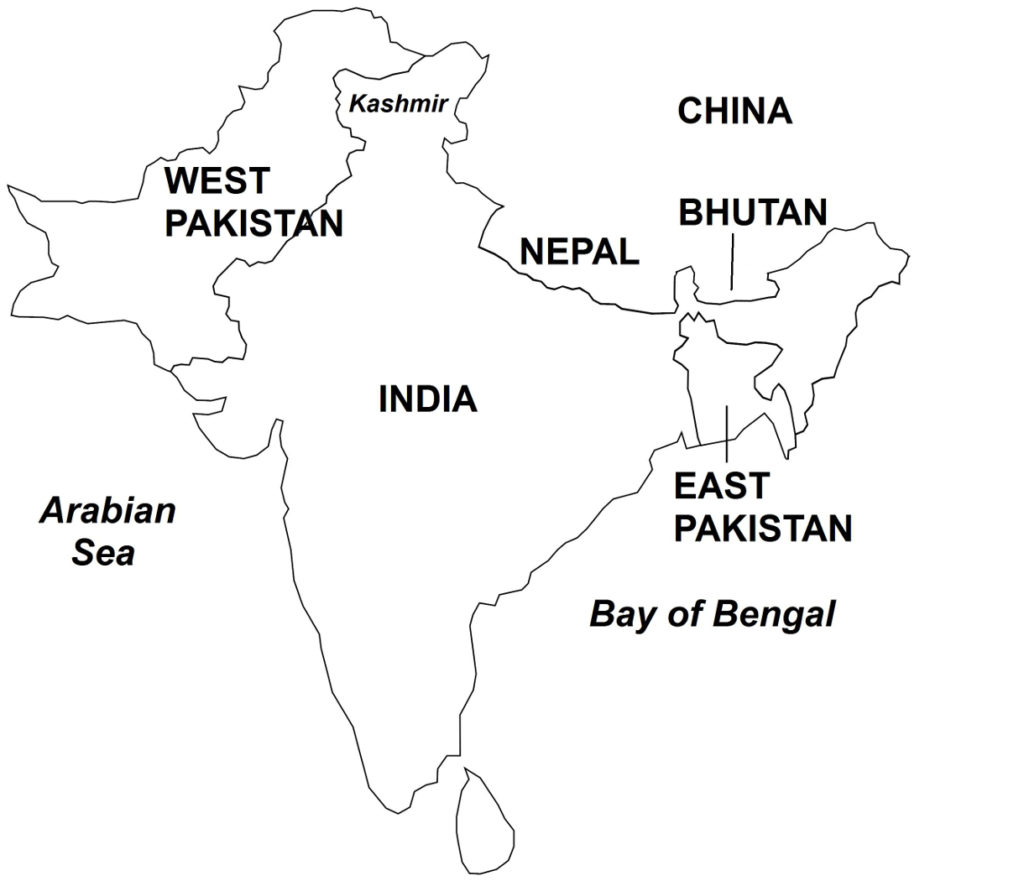The United Nations (UN) released two previously approved resolutions for a ceasefire and the future of Kashmir, which were accepted by India and Pakistan. The war officially ended on December 31, 1948.
On January 5, 1949, the UN approved the following:
1. Pakistan must withdraw its forces from Kashmir;
2. India must also withdraw its forces from Kashmir, but leave a small police contingent to maintain local peace and order;
3. After these two stipulations are met, Kashmiris will hold a plebiscite to decide the future of their land.
(Taken from Indian-Pakistani War of 1948 – Wars of the 20th Century –Vol. 2)
Background On August 15, 1947, the new state of Kashmir (Map 1) found itself geographically located next to India and Pakistan, two rival countries that recently had gained their independences after the cataclysmic partition of the Indian subcontinent. Fearing the widespread violence that had accompanied the birth of India and Pakistan, the Kashmiri monarch, who was a Hindu, chose to remain neutral and allow Kashmir to be nominally independent in order to avoid the same tragedy from befalling his mixed constituency of Muslims, Hindus, and Sikhs.
Pakistan exerted diplomatic pressure on Kashmir, however, as the Pakistani government had significant strategic and economic interests in the former Princely State. Most Pakistanis also shared a common religion with the overwhelmingly Muslim Kashmiri population. India also nurtured ambitions on Kashmir and wanted to bring the former Princely State into its sphere of influence. After Kashmir gained back its sovereignty, the British colonial troops departed; consequently, Kashmir was left only with a small native army to enforce peace and order.
War On October 22, 1947, when rumors surfaced that Kashmir would merge with India, Muslim Kashmiris in the state’s western regions broke out in rebellion. The rebels soon were joined by Pakistani fighters who entered the Kashmiri border from Pakistan. The rebels and Pakistanis seized the towns of Muzzafarabad and Dommel (Map 1) where they disarmed the Kashmiri troops, who thereafter also joined the rebels.
Within a few days, the rebellion had spread to Baramula and threatened Srinagar, Kashmir’s capital. The Kashmiri ruler fled to India, where he pleaded for military assistance with the Indian government. The Indians agreed on the condition that Kashmir be merged with India, to which the Kashmiri ruler gave his consent. Soon thereafter, Kashmir’s status as a sovereign state ended. On October 27, 1947, Indian forces arrived in Srinagar and expelled the rebels, who by this time, had entered the capital.
Earlier, India and Pakistan had jointly agreed to a policy of non-intervention in Kashmir’s internal affairs. But with the territorial merger of India and Kashmir, Indian forces gained the legal authority to occupy the former Princely State. The Pakistani government now ordered its forces to invade Kashmir. The Pakistan Armed Forces chief of staff, however, who was also a British Army officer, refused to comply, since doing so would pit him against Lord Mountbatten, the British Governor General of India, who had ordered the Indian troops to Kashmir. With the Pakistani military leadership in a crisis and its army placed on hold, the Indian Army virtually deployed unopposed in Kashmir and secured much of the state.
In early November 1947, the Gilgit Scouts, a civilian paramilitary based in the Gilgit region in northern Kashmir, broke out in rebellion over some disagreement with the Kashmiri government. The Gilgit Scouts soon were joined by tribal militias from Chitral in northern Pakistan. Together, they wrested control of the whole northern Kashmir.
By mid-November 1947, the Indian Army’s counter-attacks in the west had recaptured Uri and Baramula and had pushed back the coalition of Kashmir rebels and Pakistani fighters toward the Pakistani border. Further Indian advances were stalled by the onset of winter, however, as the Indian troops were not prepared for fighting in the cold, high altitudes and were encountering logistical problems.
With the Indian forces settling down to a defensive position, the rebel coalition forces went on the attack and captured the towns of Kotli and Mirpur in the south, thereby extending the battle lines on the west to a nearly north to south axis. In southwest Kashmir, the Indians took Chamb, and fortified the key city of Jammu, which remained in their possession throughout the war.

India and Pakistan. Diagram shows India and the two “wings” of Pakistan (West Pakistan and East Pakistan) on either side. Kashmir, the battleground during the Indian-Pakistani War of 1947, is located in the northern central section of the Indian subcontinent
With the arrival of spring weather in May 1948, the Indians launched a number of offensive operations in the west and retook the towns of Tithwail, Keran, and Gurais. In the north, a daring Indian attack using battle tanks at high altitudes captured Ziji-La Pass and Dras. But later that year, the arrival of Pakistan Army units in rebel-held Kashmir in the west stopped further significant Indian advances.
Pakistan Army units also were deployed in Kashmir’s High Himalayas to augment the Gilgit-Chitral rebel coalition forces. Together, they advanced south and captured Skardu and Kargil, and threatened Leh. A counter-attack by the Indian Army in May 1948, however, stopped the Pakistan Army-led forces, which were pushed back north of Kargil.
